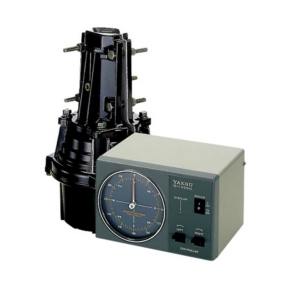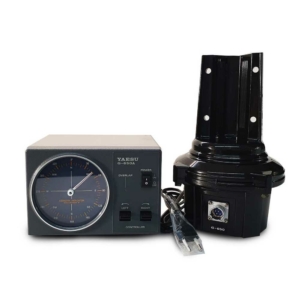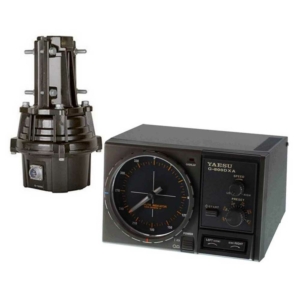Antenna Rotator Systems
In marine communication, precision and reliability are paramount to successful operations. Tecomart’s antenna rotator systems stand as a testament to these principles, becoming Singapore’s go-to solution for ship owners and industry professionals.
Antenna Rotators
Weather can be unpredictable, especially due to global warming. To ensure reliable communications with other devices, it is important to use a weatherproof antenna rotator system. Antenna rotators are motorised units that can help you get better reception from different directions. These systems are designed to withstand the harshest weather conditions, so you can stay connected no matter what comes your way.
Components of Antenna Rotators
Antenna rotators consist of several components, including:
- Rotor Unit: The rotor unit is the central component of an antenna rotator and is responsible for physically rotating the antenna. It is typically mounted on a mast or tower and attached to the antenna.
- Control Box: The control box is the component that controls the rotation of the rotor unit. It contains a motor, gears, and other mechanical components that work together to rotate the antenna. The control box also contains the electronics that allow the user to remotely control the rotation of the antenna.
- Drive Unit: The drive unit is the component that provides power to the rotor unit. It typically consists of a motor and gear train that transmits the rotational force from the control box to the rotor unit.
- Control Cables: The control cables are the wires that connect the control box to the rotor unit. They carry the electrical signals that control the rotation of the antenna.
- Mast Mount: The mast mount is the component that attaches the rotor unit to the mast or tower. It is important to use a strong and stable mount to ensure that the antenna can rotate smoothly and withstand wind and other environmental conditions.
Finding the Right Antenna Rotator System
Effective marine communication hinges on choosing the right antenna rotator system. These rotators optimise signal reception by adjusting antenna direction, and their compatibility with Radio Frequency (RF) equipment is non-negotiable. Incompatibilities can degrade signal quality and impact equipment longevity.
In marine scenarios, installing your antenna rotator system requires awareness and understanding of the rotator’s turning and braking capabilities. A rotator not aligned with the antenna’s demands, especially during storms, is prone to damage, often to its gears. Rotator failure occurs when the antenna rotator is too small for the application, causing damage to its gears during storms. This typically happens when the rotator’s turning and braking capabilities are under-specified. That’s why it’s important to ensure the rotator’s turning capability is sufficient.
To determine the turning and braking capability, calculate the K-Factor, where K = Turning Radius x Weight of Antenna. Calculator the K-Factor (in Foot Pounds) for each antenna and add the K-Factors together. Next, compare both the K-Factor and the Surface Area (in Square Feet) of your antenna(s) to the specifications. The rotator is safe if both are within the ratings.
When setting up your communication or broadcast system, selecting the suitable rotator for your antenna cannot be overemphasised. Here’s a quick guide to help you navigate this crucial decision.
1. Understand Your Antenna Type
Different antennas come with varied weight, size, and wind-loading characteristics. Familiarise yourself with your antenna’s specifications.
- Yagi Antennas: Often require robust rotators due to their size and wind load
- Dipole and Vertical Antennas: Usually lighter, allowing for more standard rotator options
- Satellite or Parabolic Antennas: Require precision-oriented rotators that can handle both azimuth (horizontal) and elevation (vertical) movements
2. Consider the Antenna’s Weight and Wind Load
The physical weight of the antenna and the additional wind load can significantly influence the rotator’s required strength. Check the rotator’s specifications to ensure it can handle the combined stress.
3. Rotator Turning Radius
The turning radius is vital for preventing mechanical obstructions during rotations. Ensure the rotator’s turning radius accommodates the length of the antenna’s longest element.
4. Precision and Control
Opt for a high-precision antenna rotator and a detailed control system if your operations involve tracking moving targets, such as satellites.
5. Durability and Weatherproofing
Given their outdoor placement, antenna rotators must withstand environmental challenges. Look for models that are weather-sealed, corrosion-resistant, and have a reputation for durability.
6. Integration with Existing Systems
Ensure the antenna rotator is compatible with your existing communication or broadcast setup, including any controllers or software you use.
7. Budgetary Constraints
While quality and reliability are paramount, finding an antenna rotator that fits within your budget is essential without compromising on the necessary features.
Browse Antenna Rotators
At Tecomart, we offer a wide selection of high-quality, weatherproof antenna rotators that will meet all your needs. Our range of antenna rotator systems, specifically designed for a wide variety of antenna installation applications, is ideal for new tower installations or system replacements.
Our catalogue of antenna rotators includes:
- Yaesu G-1000C Antenna Rotator: The Yaesu G-1000C Antenna Rotator is a high-performance device designed to support medium and heavy-duty applications. This rotator features presets, making it easy for users to quickly set and maintain their desired antenna direction. The total rotation range of this device is 450 degrees, allowing for maximum coverage and flexibility. Whether you are using a directional antenna for amateur radio or for other purposes, the Yaesu G-1000C antenna rotator is the ideal solution for your needs. Its durable construction and precise control make it an excellent choice for professionals and hobbyists alike.
- Yaesu G-550 Elevation Rotator: The Yaesu G-550 Elevation Rotator is the perfect solution for adding elevation capability to an existing azimuth rotation system. With 180 degrees of rotation, this rotator provides complete coverage from horizon to horizon. The included controller features a large, easy-to-read display metre that accurately shows the rotator’s position. Whether you are using a directional antenna for amateur radio or for other purposes, the Yaesu G-550 Elevation Rotator provides reliable and precise control over your antenna’s elevation.
- Yaesu G-650A Medium Duty Rotator Systems: The Yaesu G-650A Medium Duty Rotator System is the perfect solution for medium-duty antenna applications. This rotator features both mechanical and electrical stops to provide precise control over your antenna’s position. The brake construction is designed to keep your antenna in place, while also allowing it to turn in the event of heavy winds. The self-calibrating indicator ensures that the rotator is always accurately positioned, even after power outages. Whether you are using a directional antenna for amateur radio or for other purposes, the Yaesu G-650A Medium Duty Rotator System provides reliable and precise control.
Buy Antenna Rotators at Tecomart
Since 1994, Tecomart has been at the forefront of radio communication solutions, consistently delivering unparalleled quality and innovation. Our legacy in the industry is built on rigorous standards, in-depth research, and a commitment to excellence. When you choose Tecomart for your antenna rotator needs, you’re not just purchasing a product but investing in decades of expertise and proven reliability. Recognised widely for our robust offerings tailored to varied RF configurations, we’ve become the trusted partner for professionals in the marine industry.
Invest in quality antenna rotator systems that will ensure secure communications and improve reception after being installed. At Tecomart, we offer some of the best antenna rotators for sale at wholesale prices, perfect for any application. Other than antenna rotator systems, we also offer a comprehensive portfolio of marine navigational and marine communication equipment, such as Handheld VHF Marine Radios and Navtex Receivers from reputable brands.
At Tecomart, we believe in merging tradition with technology, ensuring seamless and efficient communication. So, if you’re looking for a reliable and durable antenna rotator for sale, be sure to check out our offerings at Tecomart today! Contact us for more information about our products and services.
Frequently Asked Questions about Antenna Rotators
- Regular inspections for wear and tear.
- Lubricating moving parts.
- Ensuring electrical connections are intact.
- Periodically checking for corrosion.
Showing all 3 results



